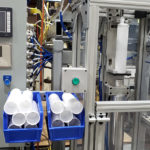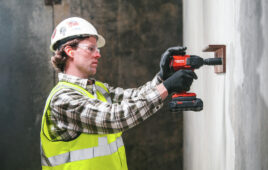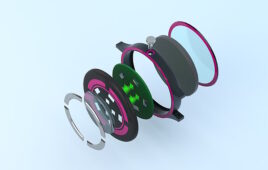Written by Jake Klaus • Marketing Director
Infrastructure Division – Adhesives Technology Corp.

There are plenty of adhesive solutions available, so it’s important to narrow down the options based on your application. Consider factors such as temperature, bond strength, project time (to allow for curing), and the overall budget.
Industrial adhesives come in as many colors, consistencies, and formulations as there are specification requirements for these products. This means for every IBC, IRC, FBC, LABC, LARC, AC308, NSF 61 requirement, there’s a fast cure, high strength, medium strength, long pot life, non-sag, ultra-tensile-strength-super-non-sag-seismic-tested-for-cracked-and- uncracked-or-medium-cracked-concrete adhesive solution that’s best for the job.
With all the options on the market, which one is ideal for your application? Given all the adhesive choices and variables for a project (such as the curing environment and potential budget constraints), it’s a conversation that could last for days.
So, for now, we’re focusing on two major classes of products: epoxies and hybrids or acrylics.
The formulas
An epoxy is formed by blending epoxy resin with some type of amine. After this combination cures for a moderate amount of time (>6 hours at 75° F), it forms long cross-linked polymer chains, known for strength, durability, and water resistance.
Epoxies are sensitive to the mix ratio (typically, 1:1 or 3:1) between the resin and hardener, so must be blended well to achieve full performance. It’s worth noting that low temperatures increase viscosity and reduce molecular mobility, which hampers the cross-linking (curing) of most epoxies.
Vinyl ester — a type of hybrid adhesive — is formed by free- radical polymerization, made by the esterification of an epoxy resin with acrylic or methacrylic acids. This process happens rapidly (<1 hour at 75° F) due to curing via a chain reaction that can occur at both low and elevated temperatures. Vinyl esters and hybrid urethane- methacrylates are less sensitive to the mix ratio (typically, 10:1) between the resin and catalyst. But they’re usually affected by the presence of moisture during cure, and much more so than their epoxy counterparts.
In many cases, an epoxy or a hybrid will meet your specification requirement, so it’s important to know the key differentiating factors between these two primary classes of adhesives.

Temperature and bond strength
The temperature at an installation site is often an important and relevant factor when deciding what type of adhesive to select.
Epoxies become harder to dispense at lower temperatures and cure very slowly as temperatures approach the 40° F mark. At extremely high temperatures, epoxies are easy enough to dispense, but they begin to lose some of their performance properties, which may be far from ideal for certain applications.
When temperatures are either very high or low, a vinyl ester, acrylic, or hybrid can offer an alternative.
Applications that carry critical safety considerations tend to specify products based on their bond strength, and not every solution will meet these stringent requirements. Typically, epoxies outperform their acrylic and vinyl ester counterparts in this arena.
Some hybrid adhesives also carry high bond strength numbers but are unlikely to compete with epoxies at the highest end of the bond strength chart. Therefore, when bond strength requirements are paramount, an epoxy is typically going to win the specification. This said, acrylic adhesives and hybrid formulations carry other beneficial characteristics that could make them ideal for your project, particularly when factors other than bond strength are important.
Additional considerations
Although temperature and bond strength often dictate adhesive selection, there is a myriad of other factors to consider. For example, epoxies are moisture insensitive and some can be applied underwater. But if time is a factor and you need a product that will install and cure quickly, think vinyl esters, hybrids, and acrylics. They cure fast for shorter return to service or load times.
 Now, what if you need to anchor in a large or deep hole? Epoxies are typically your best choice, thanks to lower viscosity options and longer working times. If you have a large job to cover, epoxies can also be used with bulk- dispensing systems and are available in several size offerings.
Now, what if you need to anchor in a large or deep hole? Epoxies are typically your best choice, thanks to lower viscosity options and longer working times. If you have a large job to cover, epoxies can also be used with bulk- dispensing systems and are available in several size offerings.
For every engineer and contractor on the job, there’s an accountant somewhere watching the budget, so cost is also a factor in deciding which adhesive is going to work. Generally speaking, epoxies will carry a lower cost per ounce. Epoxies also offer a longer shelf life, with some exceeding 24 months.
Acrylics and hybrids carry a larger price tag and usually come with a shelf life of 12 to 18 months. However, they can make up the cost per ounce difference by providing less downtime on the project and higher constructability rates. Clearly, you have options.
There are often several formulations that will meet the specification for a given project so when in doubt, reach out to an adhesives manufacturer and leverage their knowledge. Choosing the ideal adhesive for the job conditions can ensure a successful project that’s completed on time and on budget.









Great article. Thanks Jake.
Thanks for an educational post that was interesting as well. In my applications bond strength to the substrate is always the primary consideration. Resistance to either water or petroleum products often matters as well.
So now I know a bit more about what to ask for.